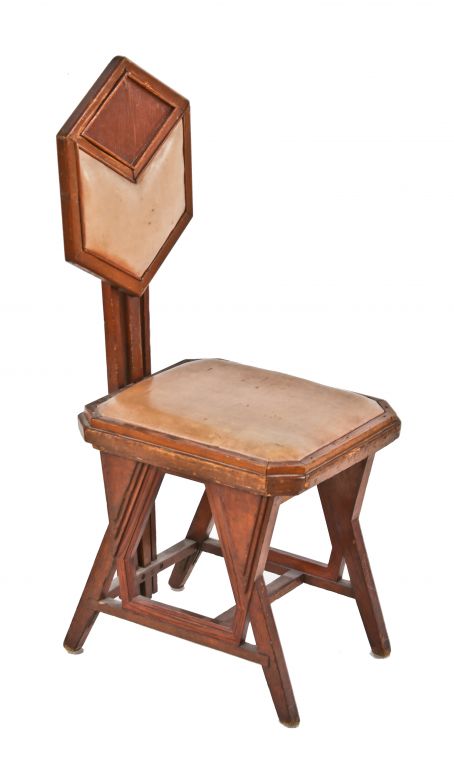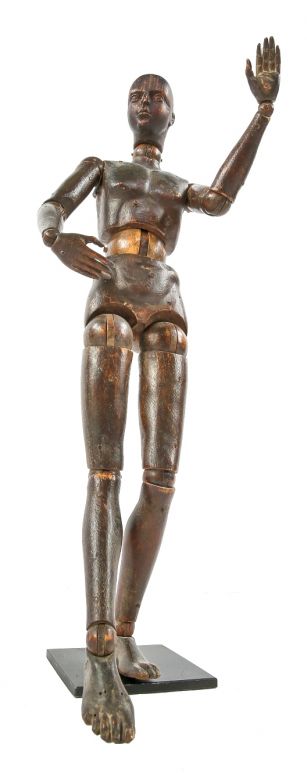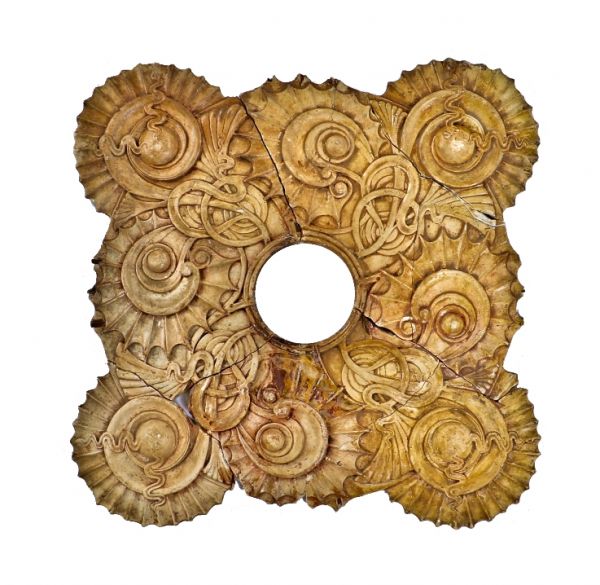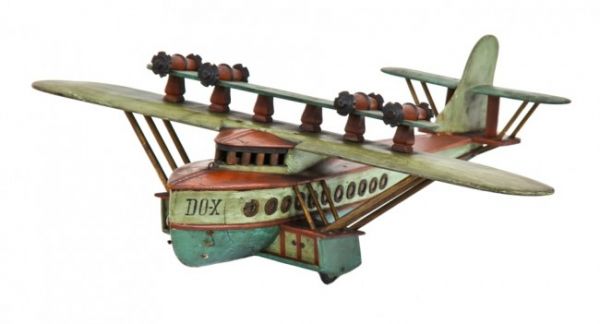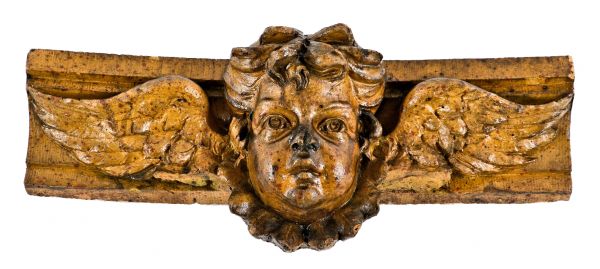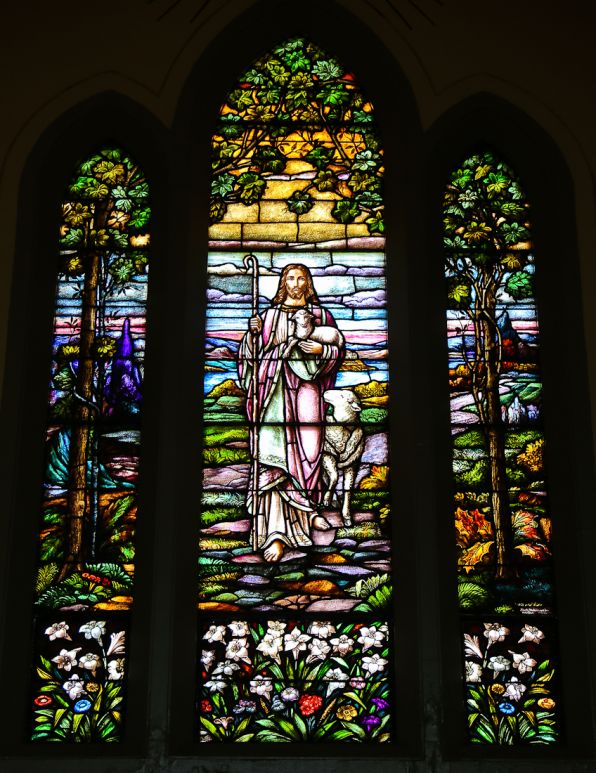original historically important hexagonal-backed or "peacock" imperial hotel oil cloth upholstered soak wood side chair designed by frank lloyd wright
BLDG. 51 MUSEUM COLLECTION
In stock
SKU
UR-26734-17
rudolph m. schindler, contracting supervisor
museum-quality 20th century american hexagonal-backed side chair salvaged from the imperial hotel (tokyo, japan), prior to demolition in the late 1960's. the iconic "peacock" side chair was designed by architect frank lloyd wright, with an original drawing for an "overstuffed chair" dating back to 1921. the chair depicted above was likely fabricated between 1925-35, with rudolph m. schindler as contracting supervisor. the hexagonal-backed chairs were used throughout the hotel. the earlier versions contained caned backrests, seats and sides. several photographs of chairs "in situ" show variations with caming and oil cloth upholstery respectively. when the hotel was demolished in 1968, some of the furniture was distributed to some american museums. the shape of the chair echoes the hotel's interior design, with its hexagonal shaped forms in the cornice and ceiling. the side chair is comprised largely of oak wood, with original varnished finish. the faded oil cloth upholstery (originally a salmon pink) is likely original to the chair. the underside contains "property of imperial hotel" in an old red paint finish. the original imperial hotel in tokyo was completed in 1890, backed by key japanese leaders, such as foreign minister count inoue kaoru and viscount shibusawa eiichi. architect yuzuru watanabe designed the hotel, known as "watanabe house", in the german neo-renaissance style. french cuisine was the official banquet fare of the imperial palace, and the imperial hotel followed that tradition. by 1917, the hotel was no longer able to accommodate the growing number of visitors, and the design was seen as outdated. to replace the original wooden structure, the owners commissioned a design by frank lloyd wright. watanabe's imperial hotel burned down in 1919. the second imperial hotel, built from 1915-1923, was the best-known of frank lloyd wright's buildings in japan. it was designed roughly in the shape of its own logo, with the guest room wings forming the letter "h", while the public rooms were in a smaller but taller central wing shaped like the letter "i" that cut through the middle of the "h". the frank lloyd wright version was designed in the "mayan revival style" of architecture. it incorporates a tall, pyramid-like structure, and also loosely copies mayan motifs in its decorations. the main building materials consisted of poured concrete, concrete block, and carved oya stone. the visual effect of the hotel was stunning and dramatic, though not unique; in recent years, architectural historians have noted a marked similarity with the cafe australia in melbourne, australia (1916), designed by prairie school architects marion mahony and walter burley griffin. the architecture heavily influenced the style of the kōshien hotel, which was constructed by wright's apprentice arata endo. the structure famously survived the magnitude 8.3 great kantō earthquake of 1923. a telegram from baron kihachiro okura reported the following: hotel stands undamaged as a monument of your genius hundreds of homeless provided by perfectly maintained service congratulations[.] congratulations[.] wright passed the telegram to journalists, helping to perpetuate a legend that the hotel was unaffected by the earthquake. in reality, the building had damage; the central section slumped, several floors bulged, and four pieces of stonework fell to the ground. the building's main failing was its foundation. wright had intended the hotel to float on the site's alluvial mud "as a battleship floats on water." this was accomplished by making it shallow, with broad footings. this was supposed to allow the building to float during an earthquake. however, the foundation was an inadequate support and did nothing to prevent the building from sinking into the mud to such an extent that it had to be demolished decades later. however, the hotel had several design features that minimized potential earthquake damage: the reflecting pool provided a source of water for fire-fighting, saving the building from the post-earthquake firestorm; cantilevered floors and balconies provided extra support for the floors; a copper roof eliminated the risk of falling debris created by traditional tile roofs; seismic separation joints, located about every 20 m along the building; tapered walls, thicker on lower floors, increasing their strength; suspended piping and wiring, instead of being encased in concrete, as well as smooth curves, making them more resistant to fracture. the hotel survived an earlier earthquake that struck tokyo during its construction. while many buildings in the area were destroyed, the hotel itself — while shaken — stood completely undamaged. the hotel came through world war ii unscathed, despite the devastating bombings of tokyo by the americans. it was commandeered for a period by the occupation forces and managed by the us government, before being returned to its owners. as the guest wings of the wright building were only three stories tall, it actually had relatively few guest rooms, and so a new tower wing was constructed directly behind wright's building in the 1950's. the hotel eventually slipped into decay as time took its toll. in a controversial decision, it was decided to demolish the old hotel and replace it with a high-rise structure, to maximize the use of land. while most of wright's building was destroyed, the iconic central lobby wing and the reflecting pool were disassembled and rebuilt at the museum meiji mura, a collection of buildings (mostly from the meiji era) in inuyama, near nagoya, where they are open to the public.
You Might Also Like
WORDLWIDE SHIPPING
If required, please contact an Urban Remains sales associate.
NEW PRODUCTS DAILY
Check back daily as we are constantly adding new products.
PREMIUM SUPPORT
We're here to help answer any question. Contact us anytime!
SALES & PROMOTIONS
Join our newsletter to get the latest information

